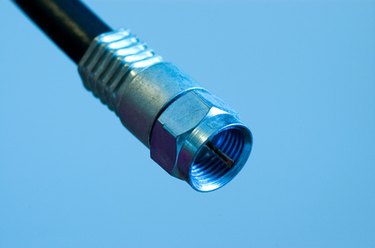
Television antennas use three types of cable connections to input signals into TVs. You can identify the different connectors by looking at the type of male connector plugs they use. The connectors have different levels of impedance. Impedance is a measure of a circuit's resistance to the flow of electrical current, expressed in units called ohms.
F Connector
Video of the Day
An F connector is the type of cable connection used in North American home cable and satellite TV connections, as well as analog and digital antenna connections. Anyone who has connected a VCR or cable box to a TV by using a thick, twist-end cable has used an F connector. The connector uses a single pin connector, made from the central wire of the cable. A threaded cylinder surrounds the connector and screws onto the TV port to secure the connection. These cables include RF (radio frequency) cables and RG (radio frequency with government standards) cables. Other forms of video transmission also use F connectors, but RCA, S-video and HDMI connections often give higher quality in those other transmissions.
Video of the Day
Twin Lead
Twin lead cable connections are an older form of connectors for North American TV antennas. This type of cable splits into two separate insulated wires at the connector end. A U-shaped connector on each wire connects to the TV's connector. Screws secure the connection. This type of connector has an impedance of 300 ohms, as opposed to the 75 ohms that an F connector uses. Few, if any, antennas still use this connection. No HD/digital antennas use twin lead connectors. A TV set with this type of connection needs an adapter that connects to the TV with a twin lead and then connects to an F-type cable.
Aerial Plug
Europe uses aerial plugs, or Belling-Lee connectors. This type of RF connector is older than the F connections used in North America. It has a single pin connector surrounded by a cylinder, like the F connection. However, the cylinder doesn't have threads and just plugs into the port. European broadcast TV antennas still use aerial plugs, but F connectors have replaced them for satellite antennas. The Belling-Lee connector does not match the cable's 75-ohm impedance on a satellite connection. This can cause distortions in the signal.